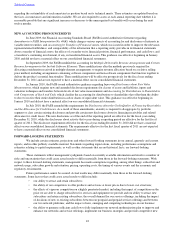Sprint - Nextel 2010 Annual Report Download - page 36
Download and view the complete annual report
Please find page 36 of the 2010 Sprint - Nextel annual report below. You can navigate through the pages in the report by either clicking on the pages listed below, or by using the keyword search tool below to find specific information within the annual report.
Segment Earnings - Wireline
Wireline segment earnings are primarily a function of wireline service revenue, network and interconnection costs
and other Wireline segment operating expenses. Network costs primarily represent special access costs and interconnection
costs which generally consist of domestic and international per-minute usage fees paid to other carriers. The remaining costs
associated with operating the Wireline segment include the costs to operate our customer care and billing organizations in
addition to administrative support. Wireline service revenue, and variable network and interconnection costs fluctuate with the
changes in our customer base and their related usage, but some cost elements do not fluctuate in the short term with the changes
in our customer usage. Our wireline services provided to our Wireless segment are generally accounted for based on market
rates which we believe approximate fair value. The Company generally re-establishes these rates at the beginning of each fiscal
year. Over the past several years, there has been an industry wide trend of lower rates due to increased competition from other
wireline and wireless communications companies as well as cable and internet service providers. For 2011, we expect wireline
service gross margin to decline by approximately $200 to $250 million to reflect changes in market prices for services provided
by our Wireline segment to our Wireless segment. This decline in wireline service gross margin related to intercompany
pricing will not affect Sprint's consolidated results of operations as our Wireless segment will benefit from an equivalent
reduction in cost of service. The following table provides an overview of the results of operations of our Wireline segment for
the years ended December 31, 2010, 2009 and 2008.
Wireline Earnings
Voice
Data
Internet
Other
Total net service revenue
Cost of services and products
Service gross margin
Service gross margin percentage
Selling, general and administrative expense
Wireline segment earnings
Year Ended December 31,
2010
(in millions)
$ 2,249
519
2,175
97
5,040
(3,319)
1,721
34%
(631)
$ 1,090
2009
$ 2,563
662
2,293
111
5,629
(3,663)
1,966
35%
(745)
$ 1,221
2008
$ 3,079
959
2,148
146
6,332
(4,192)
2,140
34%
(965)
$ 1,175
Wireline Revenue
Voice Revenues
Voice revenues decreased $314 million, or 12%, in 2010 as compared to 2009 and decreased $516 million, or 17%,
in 2009 as compared to 2008. The 2010 and 2009 decreases were primarily driven by volume declines due to customer churn as
well as overall price declines. Voice revenues generated from the sale of services to our Wireless segment represented 33% of
total voice revenues in 2010 as compared to 31% in 2009 and 26% in 2008.
Data Revenues
Data revenues reflect sales of data services, including ATM, frame relay and managed network services. Data
revenues decreased $143 million, or 22%, in 2010 as compared to 2009 and decreased $297 million, or 31%, in 2009 as
compared to 2008 due to declines in frame relay and asynchronous transfer mode (ATM) services as subscribers migrated to IP-
based technologies. Data revenues generated from the provision of services to the Wireless segment represented 27% of total
data revenue in 2010 as compared to 19% in 2009 and 13% in 2008.
Internet Revenues
Internet revenues reflect sales of IP-based data services, including MPLS, VoIP and SIP. Internet revenues decreased
$118 million, or 5%, in 2010 from 2009 as compared to an increase of $145 million, or 7%, in 2009 from 2008. The 2010
decrease was due to a decline in new IP customers with lower market rates as a result of increased competition. The 2009
increase was due to higher IP revenues as business subscribers were increasing requirements to support wireless customer's
data traffic, in addition to revenue growth in cable VoIP, which experienced a 15% increase in subscribers in 2009 as compared
to 2008. Internet revenues generated from the provision of services to the Wireless segment represented 10% of total Internet
revenues in 2010 as compared to 11% in 2009 and 9% in 2008. Some MSO's are in the process of in-sourcing their digital voice
products for which the transition and associated revenue reductions will occur over the next several years with a decrease of
approximately $200 million to occur in 2011.
Table of Contents
34
























